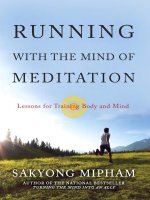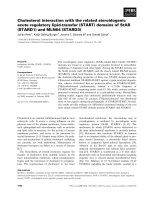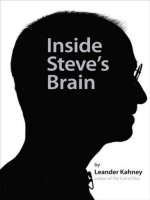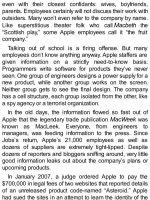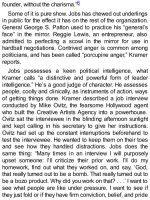Reading with the right brain read faster by reading ideas instead of just words ( PDFDrive )
Bạn đang xem bản rút gọn của tài liệu. Xem và tải ngay bản đầy đủ của tài liệu tại đây (3.76 MB, 236 trang )
READINGWITHTHERIGHTBRAIN
©Copyright2014DavidButler
Praisefor
READINGWITHTHERIGHTBRAIN
Unlikemanyother“speedreading”strategiesavailable,ReadingwiththeRight
Brainisnotagimmick;it’sauniquemethodthatallowsyoutomoreeffectively
assimilatewhatyoureadinashorteramountoftime.
AmandaJohnson,M.A.,
AssistantProfessorofEnglish,CollinCollege,Plano,Texas
David Butler and I have been friends for five years and have enjoyed many
interestingconversationsaboutreadingandcomprehension.Ihavealwaysfound
histhoughtsonthissubjecttobeincrediblyuniqueandinsightful.Readingwith
theRightBrainhasgivenDavidaplacetocollecttheseideasinoneplace,and
make them easy to understand for anyone wishing to improve their reading
skills.
This book includes not only original theories and techniques for reading
improvement, but also a totally exclusive method of presenting practice
exercisesthatmakesitextremelyeasytobeginreadingwholeideasatatime.
Pickupthisbookandstartreadingwithyourwholebrain.
RichardSutz,CEO,
TheLiteracyCompany,www.EfficientReading.com,
Authorof“SpeedReadingforDummies”
IstronglyrecommendDavidButler’snewbookReadingwiththeRightBrainas
oneofthemostinnovatenewapproachestospeedreadingonthemarkettoday.
Forthepastyear,DaveandIhavediscussedinemailexchangescrucialissues
about reading comprehension and the history of speed reading instructions.
Dave’s unique approach emphasizes the importance of reading with the right
sideofthebrainwhichhelpsthereaderquicklycomprehendatextbyconverting
groupsofwordsintoimagesandconcepts.
Itisamazingtomethatsomuchcouldhavebeenwritteninsomanyyearssince
EvelynWoodaboutspeedreadingandnoonecameupwiththeideaof“speed
comprehension.” All the other programs emphasize rapid eye movement over
text, promising that comprehension would follow, which it usually didn’t. The
conceptoffocusingoncomprehensionfirsthasbeenthemissinglink.
Reading with the Right Brain, is a “must read” for peoples interested in
improvingtheirreadingcomprehensionandspeed.
Dr.JamesYoung,
ProfessorofEnglish,WeberStateUniversity,Ogden,Utah
David Butler gets to the core of reading comprehension in Reading with the
Right Brain, with effective techniques and exercises to focus your attention on
meaning versus words. This book will speed up your reading, increase your
comprehension, and make reading a pleasurable pursuit of new worlds of
knowledge rather than slow torture that only leads to confusion. Read it and
learn!
DanielleEllis,
Mother,editor,and6thgradeteacher
TableofContents
PraiseforReadingWithTheRightBrain
Introduction
Chapter1:GettingStarted
Chapter2:HowCanYouReadFaster?
Chapter3:YourNewReadingExperience
Chapter4:TheBasics
Chapter5:Skills
Chapter6:AncientHistory
Chapter7:ModernHistory
Chapter8:TextingtheBrain
Chapter9:ReadingwiththeBrain
Chapter10:Mindset
Chapter11:Comprehension
Chapter12:Habits
Chapter13:Visualizing
Chapter14:Conceptualizing
Chapter15:ReadingSpeeds
Chapter16:ComprehensionSpeeds
Chapter17:Techniques
Chapter18:MythicalExercises
Chapter19:MythicalStories
Chapter20:ReadingonYourOwn
TheEnd
AbouttheAuthor
Introduction
Islammedthebookshut.WhywasIsuchafrustratinglyslowreader?Andwhy
couldn’tIrememberwhatIread?
I was sitting in my yard, in the shade of the tall white birch trees, beneath the
blue summer sky, reading a book I was very interested in. But I couldn’t help
getting angry at how much time the reading was taking me and how poor my
comprehensionwas.HowcouldIenjoyabookifIhadtoreaditinslowmotion?
Andthenjustforgetitall?
Thiswasmeseveralyearsago.Andifthissoundslikeyou,readon.Icanshow
youhowtoreadfasterandunderstandmore,byreadingwithmoreofyourbrain;
specifically the powerful, intuitive, big-picture right hemisphere. Although not
normallyassociatedwithreading,thissideofyourheadhasauniquecapability
ofquicklyvisualizingandconceptualizingentirecomplexideas.
Readingwiththerightbrainisatechniquewhichopenedthedoorstoreadingfor
me.Thisisnotlikeanyothertechniqueyoumayhavealreadytried;believeme,
I’vetriedthemall.Thisisdifferent.
Thisbookisaboutlearningtoreadconceptuallyandimaginingandvisualizing
what you are reading. Reading conceptually is not just another speed reading
trick, but a different way of thinking. By learning to use your right brain’s
visualizing abilities, you can end the lazy habit of merely reciting words, and
learntoreallythinkabouttheideas.
Thisbookexplainshowstrongercomprehensionleadstofasterreading,howthe
history of reading developed, and how the brain manages to accomplish this
miracle.Thereisalsoadiscussiononhowtoside-stepbadreadinghabitsandan
examinationofpopularspeedreadingmyths.
Thejewelofthisbookthoughisthesetof20uniquereadingexercises,which
make it easy to learn to read with the right brain by guiding your attention to
eachoftheshort,meaningfulpiecesofinformationwhichsentencesaremadeof.
Thesespeciallyformattedexerciseswillgiveyouaneasywaytoexperiencehow
itfeelstoreadfasterandtoreadwithbettercomprehension.Byspendingalittle
timepracticingwiththeseexercises,youcandiscoverthepowerofreadingwith
therightbrain.
Frustration
Ihad alwayswished I was abetter reader. IwantedtoreadmorebutIwasso
slow.Iwasinterestedinnon-fictionbooks,especiallyhistoryandscience,butif
thepointofreadingnon-fictionwastoacquireandretainknowledge,thenthis
wasprobablythesingleleasteffectiveactivityIeverengagedin.NotonlywasI
slow, but after spending dozens of hours getting to the end of a book, I only
retainedthefoggiestideaofwhatIhadread.
Ihadalwaysbeenfrustratedbyhowmuchtimemyreadingtook.Andnomatter
how much I read, I was still slow. I wanted to improve but didn’t know how.
NothingItriedworked.
Asayoungboy,Iwouldseeadvertisementsthatpromisedtoteachmeto"speed
read." I don’t remember what these courses cost, but it must have been more
thanIcouldaffordonmyallowance.
Inhighschool,Ifinallyhadthechancetotakeanightcourseonspeedreading—
onenightaweekfortenweeks.Animpressivelookingmachinedisplayedtext
inshortsegments,oneatatime,withacontrolforspeedadjustment.Itseemed
likethisshouldworkforsure,butintheendithadnorealeffect.Thefasterthe
textdisplayed,theworsemycomprehensionwas.
Itriedseveralspeedreadingbooksandcoursesduringhighschool,college,and
beyond,butwasalwaysdisappointed.
Reading well should have been in my genes. My father and mother were
excellent readers. My mother loved to read fiction and my father loved nonfiction.Myfatherwasself-taughtsince8thgrade,butbecauseofhispassionfor
reading,hecouldspeakintelligentlyonpracticallyanysubject.
Butitdidn’tlooklikeIhadinheritedmyparents’readingskills.Ialsofoundit
difficult to maintain concentration and I had a horrible memory. What was
wrongwithme?MaybeIjusthadaslowbrain.MaybeIcouldneverreadfaster.
Discovery
Thenonedayattheageof49,inthesummerof2000,Iwassittinginmyyard
tryingtogetthroughabookontheinterestingscienceoffractals.Butagain,it
wasastruggle.
Icouldn’tstanditanymore.Itseemedstupidtospendsomuchtimereadingwith
solittletoshowforit.Ishutthebook.
I sat holding the closed book, wondering if I should force myself to continue
reading.Ididn’tknowwhattodo.IwouldbeaquitterifIgaveup,butafoolto
wastesomuchtimeonabeautifulsummerday.
I reopened the book and stared at the page… and then something interesting
happened.Asmymindidled,Ibegantonoticepatternsinthearrangementofthe
words.Therowsofspacesseemedtoformhorizontal,slanted,andverticallines
thatoutlinedblocksofwords.
I played with this illusion for a while, but then this mental rest stop led me to
wonder if there were patterns in the ideas too. Just as these clumps of words
formed visual patterns, there were probably clumps of words that created
patternsofideas.Whatifreadingin“ideaclumps”wouldmakereadingfaster?
Grouping letters into words is easy because of the spaces between words, but
whataboutideas?Ideasusuallyrequiremultiplewords;shorterthansentences,
butlongenoughtoformcompletepiecesofunderstandableinformation.Whatif
I tried to concentrate on these complete ideas instead of individual words? I
grabbed a pencil from the house and started marking off groups of what I
thoughtsoundedlikemeaningfulchunksofwordswithslasheslikethis:
Butbeforewegointoanintroductorydiscussionofwhatchaostheoryistrying
toaccomplish,letuslookatsomehistoricalaspectsofthefield.Ifwelookatthe
developmentofthesciencesonatime-scaleonwhichtheeffortsofourforebears
are visible, we will observe indications of an apparent recapitulation in the
presentday,evenifatadifferentlevel.
Andwow!SuddenlywhenIreadthesephrasesascompleteunitsofmeaning,the
ideasseemedtojumpoffthepage,straightintomymind!
I marked up and read several more pages. This looked like a breakthrough. I
couldreadthetextfaster,plusthetextwaseasiertounderstand.
This was the solution I had been looking for. There was one problem though.
HowcouldIreadlikethiswithoutneedingtofirstmanuallymarkupthetext?
Asadesignengineer,itwasdifficulttoleaveaproblemlikethisalone.Infact,it
wasmoreliketheideaownedmethanviceversa.Itwasaninterestingchallenge,
and it also looked like it might help me overcome my long-time struggle with
reading.
A few weeks later, I came up with an interesting idea for a computer program
that could automatically divide text into meaningful phrases. After learning a
little programming, I put together a test of this idea and tried this automatic
phrase-parser on some text from an online news story. I displayed the phrases
oneatatimeandIwasimmediatelyconvincedthatIwasontosomething.The
resultsweren’tperfect,butitdefinitelymadethetextfastertoreadandeasierto
understand.
Development
Afterthisdiscovery,Ispentthenextfewyearsimprovingthealgorithm,andalso
makingtheprogramavailableonlinetoseeifothershadthesameresponseIdid.
Thisoriginalonlinereadingtool,whichcanstillbefoundatspeedreader.com/v1,
resultedinplentyofpositivefeedback,whichinturn,motivatedmeevenmore
tocontinueworkingonit.
IwassleepinglateonemorninginJanuary2009,whenIwaswokenbyaphone
call.ItwastheCEOofacompanythatteachesspeedreading.Hehadseenmy
website and wanted to discuss licensing my algorithm for use in his own
software. This very nice gentleman flew out to California for a couple of
meetings,andoverthenextfewmonthsweworkedoutanagreementandsigned
alicensingcontract.
I was walking on a cloud. Imagine, licensing my idea! But unfortunately the
deterioratingeconomyhadotherplansforme.Afterseveralmoremeetingswith
theCEOandworkingformonthswithhiscompanyprogrammertoaddthisnew
feature to their software, things ground to a halt. Their updated software was
neverreleased,andeventuallyitbecameevidentthatitprobablyneverwouldbe.
Butwhileworkingwiththiscompany,somethingelsehappened.Theyhadasked
metohelpthemdeveloplessonplansaroundthismethod,andtheplansIcame
upwitharewhatledtothecreationofmyowncoursenowatreadspeeder.com.
The company had also asked for my ideas about why this method worked so
well.ItwasincomingupwithanswerstothesequestionsthatIrealizedfaster
readingmostlyrequiredfasterthinking,andtheonlyeffectivewaytothinkfaster
is to process more information at a time—that is, to read whole ideas or
thoughtunits,insteadofwords.
I could see that reading these thoughtunits was a faster way to read and
comprehend,butreadingthiswayalsotookmoreconcentration,andthislevelof
concentration was sometimes difficult to maintain. What could a reader do to
holdtheirattentiononthelargerideas?
ThenIdiscoveredthatifIvisualizedwhatIwasreading,Iwouldautomatically
thinkinlargerconcepts.Byconcentratingonvisualimages,Iwasencouraging
mybraintothinkofthelargerideas.EvenifIcouldn’talwaysthinkofanactual
image, the attempt to visualize was still focusing my attention on mental
conceptsratherthanwords.
AsIthoughtaboutthisvisualizingtechnique,IrealizedI’dseensomethinglike
thisbefore.DrawingontheRightSideoftheBrainbyBettyEdwardsisavery
effectivebookforlearningtodraw.Thebookwasfirstpublishedin1979,when
thescienceoflateralbrainfunctionwasnew.Thebookexplainedhow,contrary
tohowtheleftbrainmerelydescribedthings,therightbrainthoughtinpictures;
and by suppressing the descriptions on the left side, you could use the special
rightbraintalenttoactuallydrawwhatyousawinsteadofwhatyouthoughtyou
saw.
This seemed similar to what I was doing when visualizing the thoughtunits. I
wasusingmyvisualrighthemispheretoimaginetherealconceptsofwhatIwas
reading.
We don’t need to explore any of this science in detail, but only need to
understandthateachsideofthebrainworksinaverydifferentway.Forthose
withacomputerbackground,basicallytheleftbrainworksasaserialprocessor,
and the right brain works as a parallel processor. This means the left brain
handles information one step at a time, while the right brain looks at whole
patternsofinformationsimultaneously.
Theresultisthatthetwosideshavedifferentpersonalitiesandseetheworldin
verydifferentways.Butit’sthepartnershipofthisoddcouplethatletsusmake
carefulanalysesaswellasleapsofintuition.
Recognizing this, it became apparent where my difficulty in reading had
occurred. I was concentrating heavily on the left-brain function of decoding
words,andwasleavingtherealcomprehensionofideasprettymuchtochance.
But this was all I was ever taught in school. Word-recognition is where most
readinginstructionends.
Mostofthemoreadvancedreadingimprovementcoursesalsoonlyconcentrate
ontheleftbrainfunctionofrecognizingwords,butthenjusthavingyoutryto
recognizethemfaster.
Tappingtherightbrainwastheanswer,andunderstandinghowtodothiscould
beabighelp.EventhoughtheReadSpeedercoursewasveryeffectiveandwellreceived,Isawtherewasstillaneedforaclearerexplanationofhowandwhy
this worked, and how to best apply this method. Collecting, clarifying, and
organizingtheseideasiswhatledtothisbook.
Thisapproachtoimprovingreadingskillsisdifferentfrompreviousapproaches
because it doesn’t suggest pushing your speed and waiting for your
comprehension to catch up. Instead, it teaches you how to strengthen your
comprehensionandthenletyourreadingspeedincreaseonitsown.Thisisnota
subtledifference.Toreadfasteryoumustforgetabouthowfastyouarereading
andputallyourattentiononwhatyouarereading.
ButfirstIwanttotellyouajoke.
InitialSpeedTest
On the following page, there is a quick test to determine your current reading
speed.Thisshorttestwillonlytakeaboutaminutetoread.
The test is in the form of a joke. A joke is used to guarantee comprehension,
becausewholikestoreadajokewithoutgettingit?Thismeansyouwon’tneed
to take a “comprehension” test because, as with any joke, you’ll know if you
“getit”ornot.
Forthistest,readexactlythewayyouwouldnormallyread.Don’tworryabout
gettingalowscore,anddon’ttrytoreadfasterthanyournormalspeed.Thiswill
beyour“before”picture.
Useastopwatch(thereareseveralfreeonesavailableontheinternet)orusea
clockandsubtractyourstartingtimefromyourendingtimetofindhowlongit
takes you to read the test. You can download a form for recording your initial
speed and your later exercise results at www.readspeeder.com/readingspeeds.html.
Afterstartingyourstopwatchormakinganoteofyourstarttime,immediately
beginreadingthetextonthenextpage.Whenyouhavefinishedreading,makea
noteofyourreadingtimeandcalculateyourwordsperminute.
Whenyou’reready,starttheclock,turntothenextpage,andbegin.Remember,
readatyournormalspeed.
Awifewaspreparingabreakfastoffriedeggsforherhusbandwhenhesuddenly
burstintothekitchen.
“Careful!” he said. “Careful! Put in some more butter! Oh, my gosh! You’re
cookingtoomanyatonce!
“Too many! Turn them! Turn them now! Now! We need more butter! Oh, my
gosh!They’regoingtostick!
“Slowthingsdownabit!Careful!Careful!Isaidbecareful!Youneverlistento
mewhenyou’recooking!Never!
“Right, turn them! Hurry up! Turn them now! Are you crazy? Have you lost
yourmind?Don’tforgettosaltthem.Youknowyoualwaysforgettosaltthem.
Usethesalt.USETHESALT!USETHESALT!USETHESALT!”
Thewifestaredathimindisbelief.“Whattheheckiswrongwithyou?Doyou
thinkIdon’tknowhowtofryacoupleofeggs?
Thehusbandrepliedcalmly,“Ijustwantedtoshowyouwhatitfeelslikewhen
I’mdriving.”
StopYourTimerNow
Notethelengthoftimeinseconds
(e.g.1minute15seconds=75seconds).
Next,calculateyourreadingspeedinwordsperminute(WPM)bydividingthe
number of words (which is 152) by the seconds you took to read, and then
multiplyingbysixty.
WPMFormula:
words/secondsx60=WPM
For example, if the reading time was seventy-five seconds, your calculation
wouldbe:
152words/75secondsx60=122WPM
When you have completed your calculation, record your speed for later
reference.
Note that although there were 161 actual words, we will use the common
standard length of 5.5 characters per word—that’s 4.5 average characters per
wordplusonespacebetweeneachword.Thiswillgivemoreconsistentresults
regardlessofchangingwordlengthsamongexercises.
WhatYourSpeedMeans
Basedonstudiesofaverageadultreaders,herearesomebasicspeedcategories:
1outof2adultscanread200WPM(“slow”readers)
1outof10adultscanread300WPM(“good”readers)
1outof100adultscanread400WPM(“fast”readers)
1outof1,000adultscanread600WPM(“speed”readers)
This should give you a general idea of the distribution of speeds. Notice that
onlyoneoutofeveryonehundredadultsreadsfasterthanfourhundredwords
per minute. This is interesting because this seems to be a common plateau for
manypeople.Itislikesomesortofphysicalspeedlimit.
Exceedingfourhundredwordsperminuteappearstorequireafundamentalshift
in mindset; readers can only pass this speed when they stop thinking of the
words.
Actualspeedreaders(over600WPM)areaparticularlyrarifiedgroup.Infact,it
makesmewonderwhereallthegraduatesofthemanyspeedreadingcoursesare
—thosecoursesthatclaimyoucaneasilylearntoreadthousandsofwordsper
minute—because these people certainly are not showing up in any of the
statistics.
Butthesestatisticsarenotmeanttodiscourageyou,onlytoofferarealitycheck.
Evenreadingfourhundredwordsperminuteisanexcellentskilltohaveanda
veryachievableonewiththismethod.Ifatwo-hundred-words-per-minutereader
coulddoublehisorherspeedtofourhundredwordsperminute,thiswouldbe
anexcellentresultwhichwoulddefinitelybeworththeireffort.
Thisdoesnotmeanit’snotpossibletocontinueimprovingtosixhundredwords
perminuteandbeyond,butyoucanneverknowhowfaranyindividualcango
since reading aptitudes are as unique as basketball or bowling aptitudes. But
withproperunderstandingoftheprocessesandtechniquesinthisbook,youwill
beonthepathtoreachingyourmaximumpotential.
Chapter1:GettingStarted
Thankyouforpurchasingthisbookandforyourtime.Timehasbecomearare
commodity,andItrulyappreciateyougivingmetheopportunitytoshareanidea
that has changed my life. It has been an adventure to write this book and to
develop the supporting concepts and theories. I am honored to be allowed to
sharethiswithyou.
Background
The theory of reading conceptually came to me after years of personal
frustration.Iamsixty-threeyearsoldandhadbeenfrustratedwithmyreading
since about the age of ten. By the time I was forty-nine, I was convinced my
slowreadingwasincurable.TheideaIhadinthesummerof2000,inretrospect,
nowseemsblindinglyobvious:READINGISCOMPREHENSION.
Thisideaismorepowerfulthanitmightsound.Itisthisdiscoverythatallowed
metoincreasemyreadingspeedfrom150wordsperminute,toaveryenjoyable
450-500wordsperminute.
Theideastemmedfromtherealizationthatcomprehensionwasn’tjustapartof
reading; on the contrary, reading was nothing but comprehension. Seeing text
and recognizing words, was only the delivery process—but it wasn’t reading.
The words delivered raw data to my brain, but this data wasn’t actually read
untilIunderstoodit.
All those speed reading books, programs, and courses that I’d tried in the past
only focused on eye movement and word recognition—that is, learning to see
wordsfaster.Butseeingisnotreading.
Many courses even suggested I could completely ignore comprehension and
somehow good comprehension would come to me AFTER I became a fast
reader. But this is never what happened. The faster I pushed my reading, the
fastertheinformationseemedtoleakoutofmybrain.
So, why were they telling me that faster reading would result in faster
comprehension?Itappearsthatthishypothesiswasbasedonnothingmorethan
theobservationthatfastreadershadgoodcomprehension.
Butwhyassumethatfastreadingleadstogoodcomprehension?Doesn’titmake
more sense the other way around―that better comprehension leads to faster
reading?
After all, what is reading? Is it only recognizing and pronouncing words?
Obviouslynot,becausethereareplentyofwordsIcanrecognizeandpronounce
butstillhavenoideawhattheymean.
For example, I can “read” this medical text: “Aspergillus was detected
histopathologically in the visceral pleural cavity.” But when I say I can read
this,ImeanIcansaythewords.Mymouthandeyesmightreadthistext,but,
sinceIamnotadoctor,allmymindprocessesis"blahblahblah."
RealreadingissomethingthatoccursAFTERyourecognizethewords.It’swhat
happens when you realize what the writer is saying, or more exactly what the
authorwasthinkingwhenheorshewrotethewords.Youhaven’treadanything
untilyou’vecomprehendedit.
OK,asinterestingasallthismightbe(tomeanyway),here’sthegoodpart.The
exercises in this book are pretty easy to do. Just practice with the specially
formattedtextsandyouwillbeginreadingwholephrasesatatime,andgofrom
hearingwordstoseeingideas.
WhyReadFaster?
Ifyoutellsomeoneyouarelearningtoreadfaster,youwillusuallyhear,“Why
wouldyouwanttoreadfaster?Howcouldyouenjoyabookifyoureaditfast?
Toenjoyyourreading,don’tyouneedtoreadslowenoughtolistentothesound
of the words, the cadence and rhythm of the language? Wouldn’t reading fast
destroythebeautyofthestory?”
But think about this. How do you know what speed is best? Unless you’re
readingaloud,howdoyouknowwhatthe“correct”speedis?Somepeopleread
fasterandsomepeoplereadslower.Isyours,ortheirs,the“right”speed?
There is no clock in your mind. Reading speed is very flexible and relative to
yourthinkingspeed.Ifyoucancomprehendfaster,youwillbethinkingfaster,
butwhatyoureadwillalwaysseemtobetakingplaceat“normal”speedinyour
mind.
Butwhileyoumaythinkyouareslowlysavoringabook,youactuallymaybe
missing much of the big picture by reading too slowly to tie the story points
together.Bythetimeyougettothemiddleofthechapterorbook,muchofthe
detailandnuanceofthebeginningmayhavefaded.
Thetruthis,thereisnorightspeed.Ifyouknowhowtoreadfaster,youcanread
fasterorslowerifyouwish.Ifyouhavetherighttools,youarefreetochoose
theoneyoupreferforeachsituation.
WhyThisMethod?
I realize the field of reading improvement has more than its share of carnival
sideshows and tacky self-help books—many of them loaded with hype,
hucksterism, pop psychology, and pseudoscientific clichés. Plus, most of these
books and courses are simply copies of one another. I’m sure you’ve already
noticedthis,andIrealizeanyself-appointedguruislikelygoingtosetoffyour
BSdetector.Soallowmetosharesomeofthecommentsthatwereemailedor
leftonmywebsiteaboutthismethod:
"Ihaveusedseveralspeedreadingprograms,buttheyweremissingwhat
thisteaches.Thisissoterrific.Thankssomuch."
"I found your course excellent and more than helpful in improving my
readingspeedandcomprehension."
“…amostenjoyablecoursethathasinvigoratedmyloveforreadingand
learning."
"Iwasnotevenanaveragereader.Butnowwithpractice,I’manaverage
readerworkingtowardsbeinganexcellentreader.Thankyou."
"Your course is perfect, really! This method makes it more pleasurable to
read!Thankyousomuch!"
"Thankssomuchforcreatingthiswonderfultool.Istrugglewithdyslexia
andhavebecomeincreasinglyfrustratedwithmyslowreadingspeed.Ijust
found your tool today, and I’ve already raised my reading speed
significantly:)Thanksagainforcreatingthiswonderfulprogram."
"This is really great for kids to use to increase their reading fluency. It
teachesthemtoreadinmeaningunitsorphrasesread.Itistransferringto
theirotherreading."
“Iamseventy-fiveandonlywithyourcourseamIabletoreadingroupsof
words."
"Great, amazing new tool. Thank you for inventing this. I absolutely love
this."
"Iuseittohelpmegetthroughmyschoolworkfasterandtoalsoreadthe
classics.Thankyou!"
"Ihavebeenthroughcountlessspeedreadingbooks,programs,etc.Thisis
byfarthebestprogramIhavefound.Thankyou."
"Hello. Thank you so much for this amazing program. I have noticed a
greatdifferenceinmyabilitytoconcentrate,read,andcomprehend.Again,
thankyousomuch."
"Ireallyappreciateyoumakingthistoolavailableforallus.Ihavealready
doubledmyreadingspeed.Thankyouverymuch."
Ienjoyreceivingcommentslikethese.Ithasbeenterrifictobeabletoimprove
myownreading,butit’sbeenfantastictohearfromotherpeoplewhohavealso
enjoyedandprofitedfromtheseideas.
LayoutofThisBook
Eachchapterofthisbookstartswithinstructionalmaterial.Theseexplanations
willgiveyouanunderstandingofwhatreadingwiththerightbrainisandhowit
canbeappliedtoyourreading.
Theinstructionalmaterialalsoincludesinformationaboutthehistoryofandthe
mental processes involved in reading. This overview of reading will help you
stayonthestraightestpathtofasterreadingandbettercomprehension.
Attheendofeachchapterthereisanexercisetopracticewhatyouhavelearned.
Eachexerciseconsistsofthefirstthousandwordsofaseparatepopularclassic
novel.
Thetextintheseexercisesisspeciallyformattedinawaythatmakesiteasyto
see the thoughtunits. This is done by indicating the separate units of meaning
with alternating black and gray text. This will identify the phrases for you, so
youcanconcentratemoreonseeingthemeaningofeachphrase.
Hereisanexampleofthistechnique.
Alicewasbeginningtogetverytiredofsittingbyhersisteronthebank,andof
havingnothingtodo:onceortwiceshehadpeepedintothebookhersisterwas
reading,but ithadnopictures orconversations init, ‘and what is the use ofa
book,’thoughtAlice‘withoutpicturesorconversation?’
Inthisexample,“Alicewasbeginning”isthefirstunitofmeaning,“togetvery
tired”isthesecond,“ofsittingbyhersister”isthethird,etc.
Thealternating blackandgraytexthelpsyouquicklyfocusyoureyesoneach
phrase,makingthesephraseseasiertograspataglance.
Each exercise is one thousand words long. The first eight hundred words are
highlighted in black and gray, and the last two hundred words are displayed
normally.Soafterreadingthoughtunitswiththehelpofthehighlighting,thelast
twohundredwordsgiveyoupracticepickingoutthoughtunitsonyourown.In
effect,thefirsteighthundredhighlightedwordswillgiveyouabitofarunning
startattheremainingunformattedtext.
Practicetheseexercisesandconcentrateonreadingwholeideas.Readingtextin
largerchunksthiswaywilltransfergreateramountsofinformationperglance,
like a high-speed broadband form of reading. It will also make reading easier
and faster because you will be concentrating on the larger, more meaningful
concepts.Readingtheselargerideaswillputmoreemphasisonwhathasalways
beenthetruebottleneckofreadingspeed:comprehension.
Comprehension must come first. Instead of pushing your speed while simply
trying to retain your comprehension, faster reading will come as the natural
resultofbettercomprehension.Ratherthanfocusingonspeedreading,youwill
befocusingonspeedcomprehension.
In addition to the practice exercises in this book, you can also find other tools
and lessons in the free online course at www.readspeeder.com. Helping
ReadSpeeder users was how this book started. This book originated from the
desire to give a more in-depth explanation of the techniques and theories
demonstrated in the ReadSpeeder course. Another reason for this book was to
supply a more natural reading experience to make reading practice more
comfortableandrealistic.
Of course, as with any skill, it will take practice to embed it into your
subconscious and really make it your own, but as concentrating on ideas
becomesahabit,itwillsoonreplaceyouroldhabitofreadingwordsandsounds.
RepeatingExercises
For the maximum benefit, try to read each exercise in one sitting. But if you
needtostopinthemiddleofanexercisebecauseofadistraction,startoveragain
atthebeginningwhenyouarereadytocontinue.Theexercisesareshortenough
thatstartingovershouldonlytakealittlemoretime,butthebestwaytobenefit
isifyoudotheexerciseslongenoughtostretchyourreadingmuscles.
Youmightbeconcernedthatstartinganexerciseoverwoulddistortyourspeed
measurementsbecauseyouwouldalreadybefamiliarwiththematerial.Itistrue
thatyouwouldmostlikelyreadfasterthesecondtime,butthatconcernmisses
themainpurposeofthepractice.Althoughanaccuratemeasureofyourreading
speed may be useful feedback, the primary benefit comes from the practice
itself.
Plus there are other benefits to repeating an exercise. Rather than having an
unfairadvantageonthesecondreading,youwillactuallybefurtherreinforcing
yourskillsinnewways.Youwillbeabletopracticevisualizingconceptsfaster
the second time since it will be easier for you to come up with visuals, which
willthereforeallowyoutomoreeasilyexperiencethetypeofreadingyouwant
to have, and to see what it feels like to fly over the words with excellent
comprehension.
PracticeExercise#1
The shift into higher reading speeds comes as a result of learning to read with
therightbrain,readingwholeideasratherthanwords.Themethodsandtheories
of this technique will be further explored throughout the book, but in this first
practicesegment,justpayattentiontohowthetextissegregatedintodistinctand
independently meaningful chunks of information. Without even trying, you
shouldbeginseeingphrasesaswholeideas.
Don’tbetooconcernedaboutyourspeed,oraboutbadhabitssuchasregression
orvocalizing.Justreadthroughthetextandletthespecialformattingguideyour
eyestothemeaningfulphrases.
Todetermineyourreadingspeed,measurethetimeittakesfromstarttofinish
and then use one of the formulas below to calculate your words per minute.
Sinceeachexerciseisexactlyonethousandwordslong,thecalculationswillbe
simpleandtheresultswillbeeasytocompare.
HerearetwowaysyoucancalculateyourWPMfortheseexercises:
1. Divide1,000bythenumberofminutes(1,000/MINUTES)
2. Divide60,000bythenumberofseconds(60,000/SECONDS)
You can download a simple form for recording your speed results at
www.readspeeder.com/reading-speeds.html.
Inthisfirstexercisethetextwillbedisplayedinslightlyshorterunitsofmeaning
than in the exercises that follow. The word-groups in this exercise will be no
longerthanthreewordseach,togiveyouaneasierintroductiontoreadingwordgroups.
As you begin this first exercise, do not be overly concerned with how you are
reading.Theblackandgrayhighlightingshouldautomaticallyguideyoutothe
larger blocks of information. At this stage, just get used to seeing text divided
intomeaningfulthoughtunits.
When you come to the unaided portion of the text, try to continue seeing the
words in meaningful groups on your own. Don’t worry about exactly which
words you group together, because there are no perfect groupings. Just try to
continueseeingmeaningfulphrases,regardlessofthephraselengthsyouchoose.
What is most important is that the phrases make sense to you and are easy to
imagine.
Whenyou’reready,beginreadingthefirstthousandwordsof
TheVelveteenRabbitbyMargeryWilliams
TheVelveteenRabbit
Therewasonceavelveteenrabbit,andinthebeginninghewasreallysplendid.
He wasfat andbunchy,asarabbit shouldbe;his coat was spotted brownand
white,hehadrealthreadwhiskers,andhisearswerelinedwithpinksateen.On
Christmasmorning,whenhesatwedgedinthetopoftheBoy’sstocking,witha
sprigofhollybetweenhispaws,theeffectwascharming.
Therewereotherthingsinthestocking,nutsandorangesandatoyengine,and
chocolatealmondsandaclockworkmouse,buttheRabbitwasquitethebestof
all.ForatleasttwohourstheBoylovedhim,andthenAuntsandUnclescameto
dinner,andtherewasagreatrustlingoftissuepaperandunwrappingofparcels,
andintheexcitementoflookingatallthenewpresentstheVelveteenRabbitwas
forgotten.
Foralongtimehelivedinthetoycupboardoronthenurseryfloor,andnoone
thought very much about him. He was naturally shy, and being only made of
velveteen,someofthemoreexpensivetoysquitesnubbedhim.Themechanical
toyswereverysuperior,andlookeddownuponeveryoneelse;theywerefullof
modern ideas, and pretended they were real. The model boat, who had lived
throughtwoseasonsand lostmostof hispaint, caughtthetonefromthemand
nevermissedanopportunityofreferringtohisriggingintechnicalterms.
TheRabbitcouldnotclaimtobeamodelofanything,forhedidn’tknow that
realrabbitsexisted;hethoughttheywereallstuffedwithsawdust likehimself,
and he understood that sawdust was quite out-of-date and should never be
mentionedinmoderncircles.EvenTimothy,thejointedwoodenlion, whowas
made by thedisabled soldiers,andshouldhave hadbroaderviews,put on airs
andpretendedhewasconnected withGovernment.Between them all thepoor
littleRabbitwasmadetofeelhimselfveryinsignificantandcommonplace,and
theonlypersonwhowaskindtohimatallwastheSkinHorse.
TheSkinHorsehadlivedlongerinthenurserythananyoftheothers.Hewasso
oldthathisbrowncoatwasbaldinpatchesandshowedtheseamsunderneath,
andmostofthehairsinhistailhadbeenpulledouttostringbeadnecklaces.He
waswise,forhehadseenalongsuccessionofmechanicaltoysarrivetoboast
andswagger,andby-and-bybreaktheirmainspringsandpassaway,andheknew
that theywere onlytoys,and wouldneverturninto anything else. Fornursery
magicisverystrangeandwonderful,andonlythoseplaythingsthatareoldand
wiseandexperiencedliketheSkinHorseunderstandallaboutit.
“WhatisREAL?”askedtheRabbitoneday,whentheywerelyingsidebyside
near the nursery fender, before Nana came to tidy the room. “Does it mean
havingthingsthatbuzzinsideyouandastick-outhandle?”
“Realisn’thowyouaremade,”saidtheSkinHorse.“It’sathingthathappensto
you. When a child loves you for a long, long time, not just to play with, but
REALLYlovesyou,thenyoubecomeReal.”
“Doesithurt?”askedtheRabbit.
“Sometimes,”saidthe Skin Horse, for he was alwaystruthful.“When you are
Realyoudon’tmindbeinghurt.”
“Doesithappenallatonce,likebeingwoundup,”heasked,“orbitbybit?”
“It doesn’t happen all at once,” said the Skin Horse. “You become. It takes a
long time. That’s why it doesn’t happen often to people who break easily, or
havesharpedges,orwhohavetobecarefullykept.Generally,bythe timeyou
areReal,mostofyourhairhasbeenlovedoff,andyoureyesdropoutandyou
get loose in the joints and very shabby. But these things don’t matter at all,
because once you are Real you can’t be ugly, except to people who don’t
understand.”
“Isupposeyouarereal?”saidtheRabbit.Andthenhewishedhehadnotsaidit,
for he thought the Skin Horse might be sensitive. But the Skin Horse only
smiled.
“TheBoy’sUnclemademeReal,”hesaid.“Thatwasagreatmanyyears ago;
butonceyouareRealyoucan’tbecomeunrealagain.Itlastsforalways.”
TheRabbitsighed.Hethoughtitwouldbealongtimebeforethismagiccalled
Realhappenedtohim.HelongedtobecomeReal,toknowwhatitfeltlike;and
yettheideaofgrowingshabbyandlosinghiseyesandwhiskerswasrathersad.
He wished that he could become it without these uncomfortable things
happeningtohim.
TherewasapersoncalledNanawhoruledthenursery.Sometimesshetook no
noticeoftheplaythingslyingabout,andsometimes,fornoreasonwhatever,she
wentswoopingaboutlikeagreatwindandhustledthemawayincupboards.She
calledthis“tidyingup,”andtheplaythingsallhatedit,especiallythetinones.
TheRabbitdidn’tminditsomuch,forwhereverhewasthrownhecamedown
soft.
Oneevening,whentheBoywasgoingtobed,hecouldn’tfindthechinadogthat

